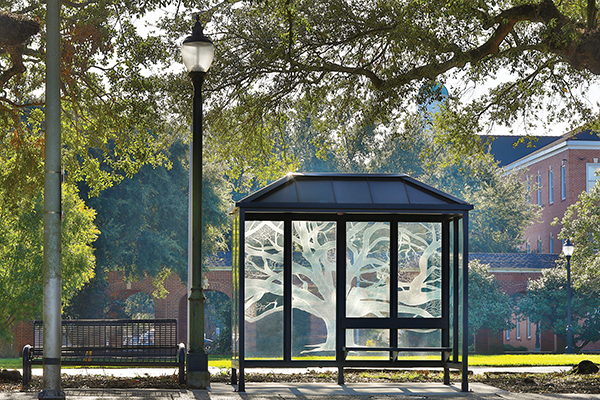Acorns don’t fall from several sprawling oak trees recently “planted” by the University of Louisiana at Lafayette. Birds don’t land on their long, flowing branches, either.
The trees are vinyl illustrations that adorn the walls of four, three-sided public bus stops along a stretch of Johnston Street that runs past the UL Lafayette campus.
“The illustrations tie each stop to one of campus’ most recognizable, significant features – its sprawling oaks,” said Gretchen LaCombe Vanicor, director of the University's Office of Sustainability.
“They also represent the University’s commitment to eco-friendliness.”
The covered bus stops were built as part of Lafayette Consolidated Government’s “Adopt a Stop” program. Only a small percentage of the city’s hundreds of bus stops have roofs. Community partners augment the 11 covered shelters that LCG completes yearly as part of the program.
UL Lafayette’s participation means people waiting for Lafayette Transit System buses in front of Foster and Maxim Doucet halls, the French House, and The Heritage at Cajun Village have a place to duck out of the rain, find shade, or take a seat.
“Many faculty, staff and students utilize public transportation to get to and from campus, particularly those who are from large urban areas. So mass transit is something we encourage and want to continue to encourage,” Vanicor said.
Beyond comfort, the bus stops are positioned to help the University achieve environmental objectives set forth in its Sustainability Strategic Plan. The master plan for campus sustainability goals was adopted in 2018.
“Fewer vehicles traveling city streets lessens greenhouse gas emissions which, along with reducing water and energy consumption, is a primary objective of the plan,” Vanicor explained.
Mariah Scallan, a 2018 UL Lafayette graduate and graphic designer in the University’s Office of Communications and Marketing, designed the bus stop oaks. Pixus Digital Printing transferred her designs onto translucent vinyl that was affixed to the bus stops to resemble etched glass.
“The project was very gratifying because oak trees are such a visible symbol of something so intertwined with the University and its identity, and so important to sustainability,” Scallan said.
In addition to the oak trees, the illustrations feature another nod to campus eco-friendliness – a small “decal” that recognizes the University’s Tree Campus USA status.
UL Lafayette has earned the designation from the Arbor Day Foundation for the 11th consecutive year. It singles out colleges and universities for effective campus forest management.
Schools must establish a tree advisory committee, devise campus tree-care plans, and enlist faculty, staff and students in conservation projects, said the Arbor Day Foundation’s Logan Donahoo. She manages the program, which was recently renamed Tree Campus Higher Education.
“College campuses are home to thousands of people who have great potential to advocate and influence; especially students who learn about the importance of tree canopies by participating in forest management projects,” Donahoo said.
Case in point: The Office of Sustainability is coordinating with AmeriCorps volunteers who are “geotagging” campus trees. The students are using an app to digitally log the location of each tree to create a comprehensive inventory with notations about species, size and health.
The details are as important as a final tally, Vanicor said. “The database will be helpful in many ways, including for making determinations about where to strategically plant trees to reduce storm water runoff, or shade sidewalks,” she explained.
Photo caption: Illustrations of oak trees that adorn four public bus stops near UL Lafayette represent a longstanding, campus-wide commitment to sustainability. The bus stops are in place to encourage mass transit, an objective of the University’s Sustainability Strategic Plan. Photo credit: Doug Dugas / University of Louisiana at Lafayette
